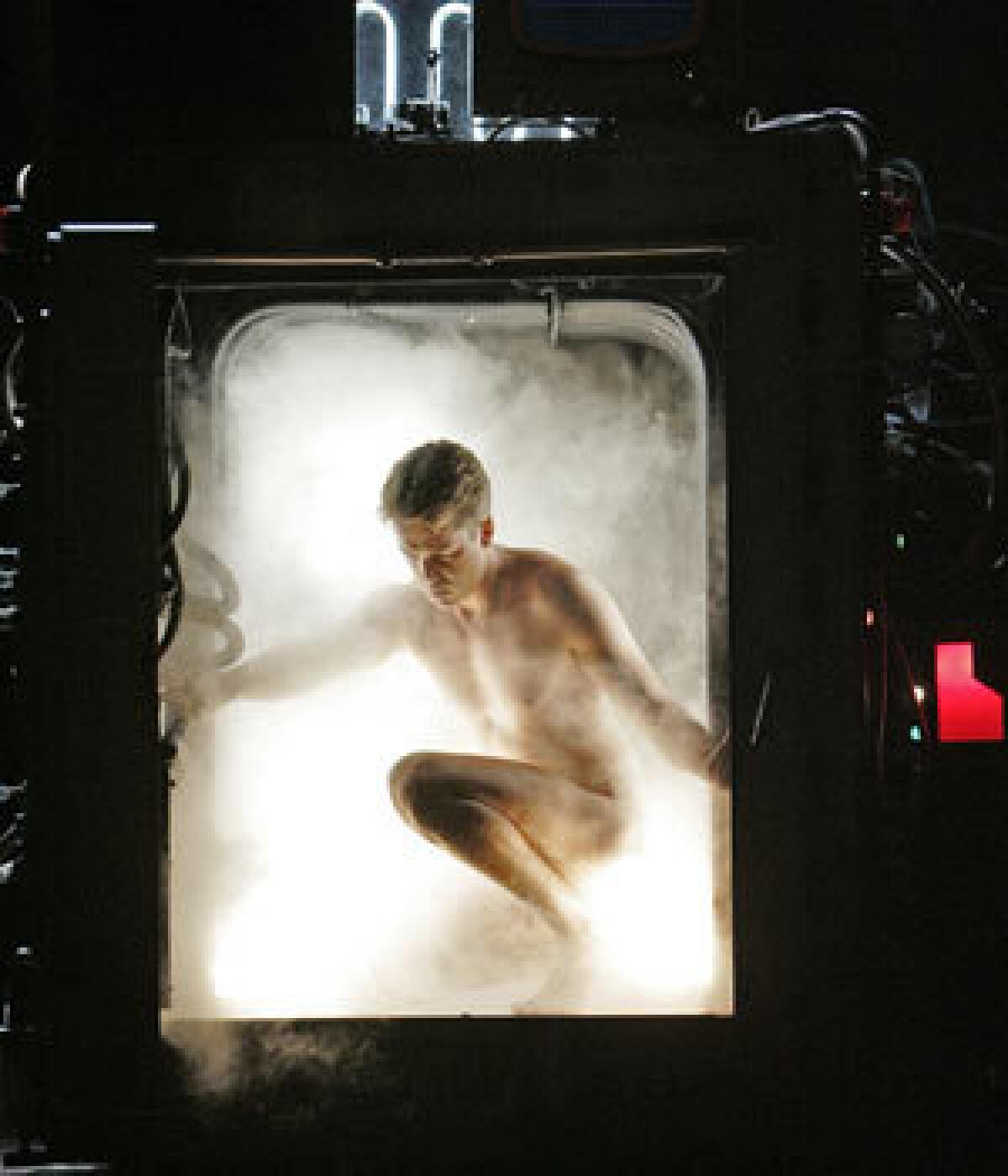L.A. Operaâs âThe Flyâ is a monster mash

Two years ago, a bass-baritone covered in gook stalked the stage of the Dorothy Chandler Pavilion. That was the medieval monster in Elliot Goldenthalâs âGrendel,â commissioned by Los Angeles Opera. Sunday afternoon, a baritone covered in gook again stalked the Chandler stage. This time it was Brundle, the scientist hero transmogrified into a Musca domestica in Howard Shoreâs âThe Fly,â inspired by the 1986 David Cronenberg horror film -- the latest opera commissioned by the company.
Just about any subject is ripe for opera. The film world and lyric stage have been influencing and stealing from each other since the days of silents. Brundlefly is no less reasonable a character for musical amplification than Rigoletto.
Yet in L.A. Operaâs ongoing monster mash (the commission before âGrendelâ was Deborah Drattellâs âNicholas and Alexandra,â which featured Rasputin), music has ranked in importance somewhere below makeup.
Iâm sorry to have to agree with the French critics who saw âThe Flyâ first and began the string of bad buzz jokes. The premiere was two months ago in Paris at the ThÊâtre du Châtelet, which co-commissioned the work. The reaction was unkind.
The level of unkindness was not entirely called for. A lot of serious work has gone into a convincing staging by Cronenberg and virtuosic performances by two of the lead singers. PlĂĄcido Domingo conducts forcefully. David Henry Hwang has written a libretto that adds a new twist or two in a tale that appeared as a short story in Playboy and was then turned into a charming horror film in 1958 starring Vincent Price before Cronenberg made it more shocking.
Shore scored that second âFlyâ effectively, even operatically. So I am at a loss to understand why âThe Flyâ has turned out so dreary, despite the inclusion of sex, nudity, puppetry and athleticism.
The short orchestral prelude begins promisingly enough with swooping repeated figures in the orchestra reminiscent of early JanĂĄcek, setting an ominous mood. There is a quick change into something more generically ominous. But after that, for more than two hours, there is little variety, little change.
The vocal writing is generally flat and conversational. Phrases often repeat; though slightly varied, they are predictable. Sexual passion and insect angst inspire similar music. So too do dorky scientists partying and toughs in a pool hall. Thick textures, thick chords and dark colors (from low strings, brass and timpani) pervade.
Cronenberg has taken pains to explain that he wanted to create an opera that was distinct from his film. He left it to Hwang to graft elements from the original George Langelaan story. Unlike the film, the opera is constructed as a flashback. The fly dies differently. Hwang has returned the story to the 1950s (although he has allowed anachronisms, such as an allusion to black holes).
Still, the general outline is essentially what Cronenberg came up with for his film. The scientist, Seth Brundle, discovers a way to decompose and recompose matter through teleporters that look like big refrigerators. But an experiment goes awry when a fly accidentally joins Seth in the teleporter; man and insect fuse at the genetic level. The flyâs DNA first gives the awkward Brundle increased strength, agility and sexual prowess, to say nothing of a superhuman appetite for candy bars. But eventually his skin peels away. He oozes fluids and becomes generally disgusting.
Hwang emphasizes the superman element -- turning Brundle into a messianic figure who proclaims his fusion as the beginning of âthe new fleshâ -- and even gives him an aria about insect politics. Veronica, a science reporter who falls for Brundle and is impregnated by Brundlefly, sings an abortion aria. But the music, alas, never quite rises to these odd occasions.
The Canadian baritone Daniel Okulitch and the Romanian mezzo-soprano Ruxandra Donose do rise to the occasion, though. Okulitch engagingly handles the transformation from nerd to fiend. He sings equally well musing about science and menacingly suspended from the ceiling. Donose proves a strongly dramatic figure.
A third character, Stathis, is an ex-lover of Veronica and her editor at Particles magazine. He is less developed than in the film, and tenor Gary Lehman, who impressively stepped in for Domingo in âParsifalâ at L.A. Opera three years ago, here sounds insecure. Ashlyn Rust is the perky Tawny Perkins, whom Brundle picks up in a pool hall after he is newly energized with the flyâs strength and endurance. Jay Hunter Morris is Marky, her boyfriend, whose hand Brundle crushes arm-wrestling.
The set by Dante Ferretti, a veteran film designer, is a strikingly intricate re-creation of a sci-fi lab. The costumes by Denise Cronenberg are conventionally â50s. Stephan L. Dupuis probably did a good job with the extensive fly makeup and decomposed creatures, but the dim lighting doesnât allow for much to be seen. The chorus, which is often the voice of the computer, is amplified into something flat and machine-like. The orchestra (many members of which sometimes work at Hollywood studios and know Shoreâs work well) plays assuredly.
And yes, the filmâs famous line, âBe afraid, be very afraid,â is heard, and more than once -- the first time with squealing music underneath that all but begs for a laugh.
The opera closes with Veronica, infected by the flyâs call for a new flesh, deciding to have Brundleâs baby. Both the original âFlyâ and the remake âFlyâ spawned sequels. Shore has clearly left the opera door open as well.
Be afraid, be very afraid.
âThe Fly,â Los Angeles Opera at the Dorothy Chandler Pavilion, 135 N. Grand Ave., L.A. 7:30 p.m. Wednesday, Saturday, Sept. 16 and Sept. 20; 2 p.m. Sept. 27. $20 to $250. (213) 972-8001 or www.laopera.com.
More to Read
The biggest entertainment stories
Get our big stories about Hollywood, film, television, music, arts, culture and more right in your inbox as soon as they publish.
You may occasionally receive promotional content from the Los Angeles Times.











